USS BREMERTON – SSN698
THE CALL OF THE 30+ YEAR REUNION
I was serving in the Navy when my father, for the first time, went to an 11th Airborne veterans’ reunion, it was in Arizona in the 1980’s, about 40 years after my father was discharged from the U.S. Army in 1946.
Although his airborne division had been having reunions for years, he didn’t have time to spare running his various businesses. Yet, as fate would have it, in those years prior to the invasion of the public internet, one of his fellow airborne vets invited him to a reunion in Arizona. Maybe it just sounded like a vacation idea and he needed to get away with mom. Through the years beforehand, dad had one or two Army buds come by to visit the house, but attending that 1st reunion started a whole new chapter in his life bringing together some of his best friends.
There are times when the culmination of events and the closing of a circle brings about profound insights.
After so many years, the call of the reunion triggers a dormant passion instilled from past experiences, experiences that you intimately shared with others in common goal and mission. It connects with something deep inside you that has been a large part of what makes you tick, whether to realize it or not.
When you serve in the military, especially in combat or in a combat unit, there’s a spirit that binds comrades together like no other experience can. You become part of an epic struggle when the success of the mission, your life and the survival of your shipmates, and the safety of your country are on the line. Even if you do not have to shed the blood of your enemy, as a fighting unit you have to go though the intense preparations for when you need to execute.
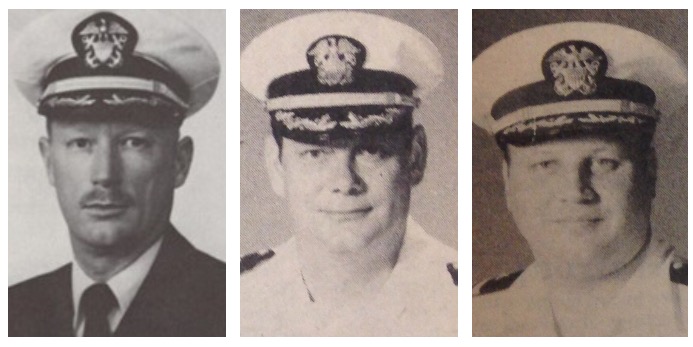
USS Bremerton Commanding Officers 1978-1988: Thomas H. Anderson, Douglas S. Wright, and Alan R. Beam
Serving in the Navy has an additional source of cohesion that paratroopers do not experience and that is sharing in the life of a ship, or in our case with the USS Bremerton, a submarine.
A U.S. Navy submarine is a front line fighting unit but under considerably different conditions than how an airborne division serves. Submarines, like paratroops, is an all volunteer outfit and qualified personnel wear their coveted insignias on their uniforms. We go through extensive specialized technical and practical training to meet the demands, withstand the stresses and deal with hardships that impact submarine crews.
Just the thought of operating and living deep in the ocean, an ocean that is predisposed to crushing a vessel through a major breech of its water tight integrity and remaining in that condition for up to months at a time, is enough to discourage most people from such an eccentric life.
A modern submariner lives within a cylindrical hull about a football field’s length, sharing that space with a nuclear reactor, equipment compactly designed into every area, enough weaponry to cause enormous destruction, and over a hundred other modern day unsung heroes of the Silent Service who were insane enough to volunteer to serve in such an environment.
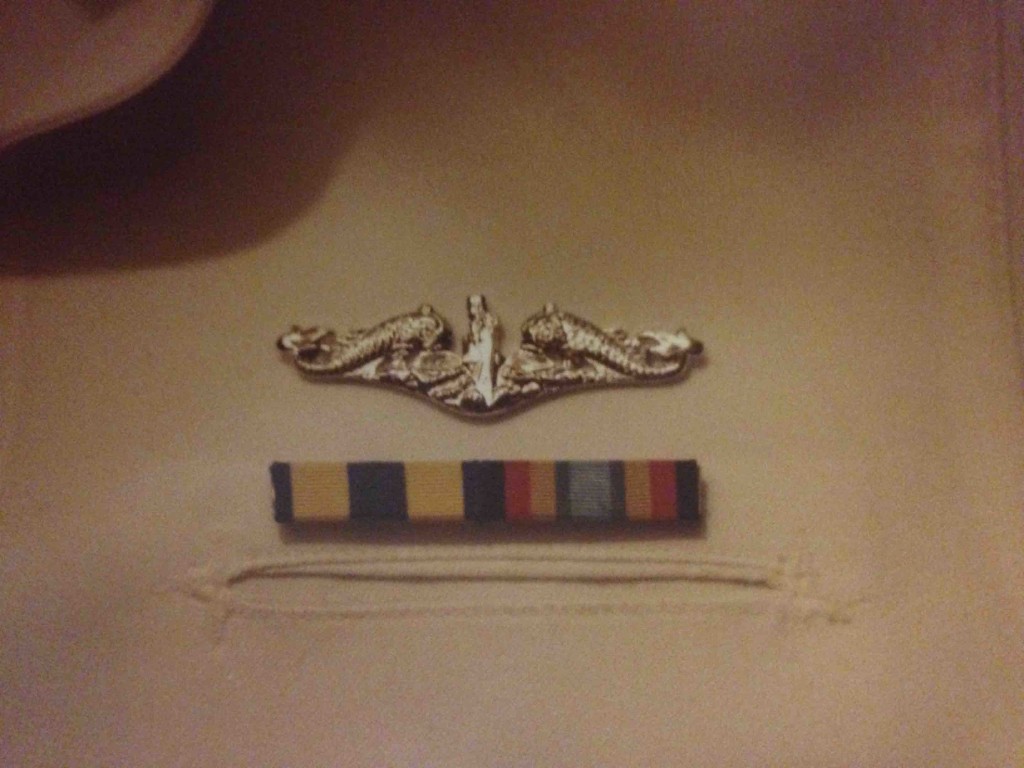
Submarine Dolphins (Enlisted) with Expeditionary and Sea Service Awards (1983). This is what you would have worn if you new to the military and served and qualified on Bremerton in 1983. Some special operations are considered for the Expeditions Award (a medal, here represented by a ribbon at left) and sea service is awarded each year if serving away from home port for over 90 consecutive days. For a fast attack boat, especially a hot running boat like the Bremerton, it is not unusual to spend over 80% of the year away from home port. The submarine truly becomes your home away from home and your shipmates your new family.
As of the writing of this article, USS Bremerton (SSN698) has the honor of being the longest-serving active duty submarine in the US Navy. Commissioned on March 28, 1981. She is a Los Angeles 688-Class Fast Attack submarine. For those of you who are unfamiliar with modern Navy submarines there are two basic types, an attack submarine is used to function in many different roles and the Fleet Ballistic Missile (FBM) submarine like the USS Ohio (SSBN-726). The Ohio-Class was originally designed to serve as one of three arms of the strategic defense Triad, being the platform for the Trident InterContinental Ballistic Missile. We call these big strategic missile carrying submarines “Boomers”.
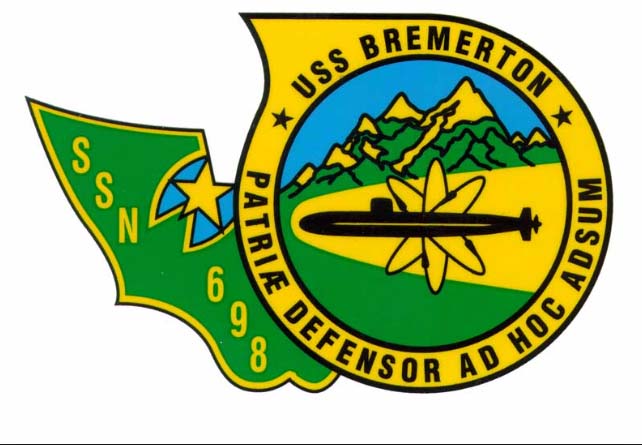
The boat’s official emblem
Attack Boat sailors tend to be saltier than their boomer counterparts, just because. Well, just because we train and tend to operate to investigate and engage rather than disengage and hide from anything and everything. It takes a different attitude to look for trouble rather than avoiding it. One documentary that studied successful British attack submarine captains, determined that one trait that seem to stand out above all else was aggressiveness.
Plus we get to visit a variety liberty ports restricted from our boomer counterparts.
Before I joined the Navy on active duty, I met a submarine Chief, Ted Luther, who, when he found out I wanted to be a Sonar Technician, talked me into volunteering for submarines. Not only did he talk me out of serving on surface ships, he immediately advised me to serve on attack boats instead of boomers. Chief Ted basically told me that the experience on an attack boat, though harder, will be more fun and exciting and help me advance in rank faster.
***
USS Bremerton in the early years – Historical Perspectives
The original crew-members of the Bremerton gradually began to arrive on board while the boat was being constructed at the Electric Boat Shipyard (EB) in Connecticut around 1978. This was only a mere three years after the end of US involvement in the Vietnam War and during the Presidency of Jimmy Carter (a former submarine qualified US Navy Officer).
The late 1970’s was a time when the military culture was strongly influenced by the decades long Cold War which began immediately after the end of World War II. The times were highlighted by the constant fear of nuclear conflict with the Soviet Union. There was hardly an elementary school child or student who wasn’t aware of this ongoing threat as “duck and hide” drills were common.
Also a strong influence on the military were the social morays introduced by the changes of the 1960’s, the time of America’s own cultural revolution.
To top things off, members of the submarine community have long been immersed into the traditions and rituals set by prior generations of submariners, particularly the legendary World War II submariners whose sacrifice and success contributed in a massive way towards victory in the Pacific Theater.
Submarines have come a really long way since the WWII era diesel boats which spent most of the time transiting on the surface and often conducting attacks on the surface, and diving only to escape or not be seen during the day. Modern submarine classes are much larger, conducting virtually all of their business underwater and in many ways, are much more civilized than their WWII counterparts, which you might expect considering you almost never come up to see the light of day. Changes in design came gradually through the decades.
Selected Los Angeles 688-Class Features
Sometimes, a change in the design of a new submarine invites ridicule from older veterans.

Los Angeles Class “fast attack” submarines were designed to act as a defense for speedy aircraft carrier groups whose speed abilities outran the older sub classes. US Navy. Image source: google.com
The Los Angeles (LA) 688 Class, with its faster speed capability and modern long range sonar known as the Q-5, was originally touted to be used to act as escorts for the modern aircraft carrier battle groups. In Bremerton’s early days, the older 637 Sturgeon Class in its various forms and special project boats like the USS Parche (SSN 683), were the backbone of US Navy underwater intelligence and ASW (anti-submarine warfare) operations but inadequate to act as an effective carrier screen. The 637’s were slower, but were also touted as being more controllable at those slow operating speeds which was often the case for intelligence work.
Watertight Compartments
The new LA Class submarines had their advantages of high speed and newer technology, but were often ridiculed by submariners from other classes of subs. One reason was the LA only had two main watertight compartments compared to the 5 in the 637 Class. The general sentiment among submarine crews was, a 637 was safer because if you had a flooding emergency, at least you could isolate the flooding to 1/5 of the boat rather than only 1/2 as you could in a 688.
Would the Titanic have remained floating if the water rushing through the gash could’ve been isolated in one area?
Aside from the obvious cost and complexity of increasing the number of watertight bulkheads, the actual engineering reasons are complex why the Navy designed 688’s with only two watertight people compartments, yet the Navy believed it effective just to be able to isolate the engine compartment (with its isolatable reactor compartment) from the forward compartment. That one water tight door going between the forward compartment and after compartment (engine room) becomes a major consideration in every emergency and casualty situations (i.e. fire, flooding, radiation leaks). Judging by the success of the class over the years, the designers must have done a good job.
It was common for older submariners also to ridicule the 688 Class as just a carrier escort and not a “real” boat. Quite frankly, there’s no end to the intra-service rivalries and insults between boat crews (we do not call submarines “ships”, that’s like calling a baseball park a “stadium”) and of the various classes, but don’t belittle a submariner from the outside as submariners stick together to fend off all outside foes.
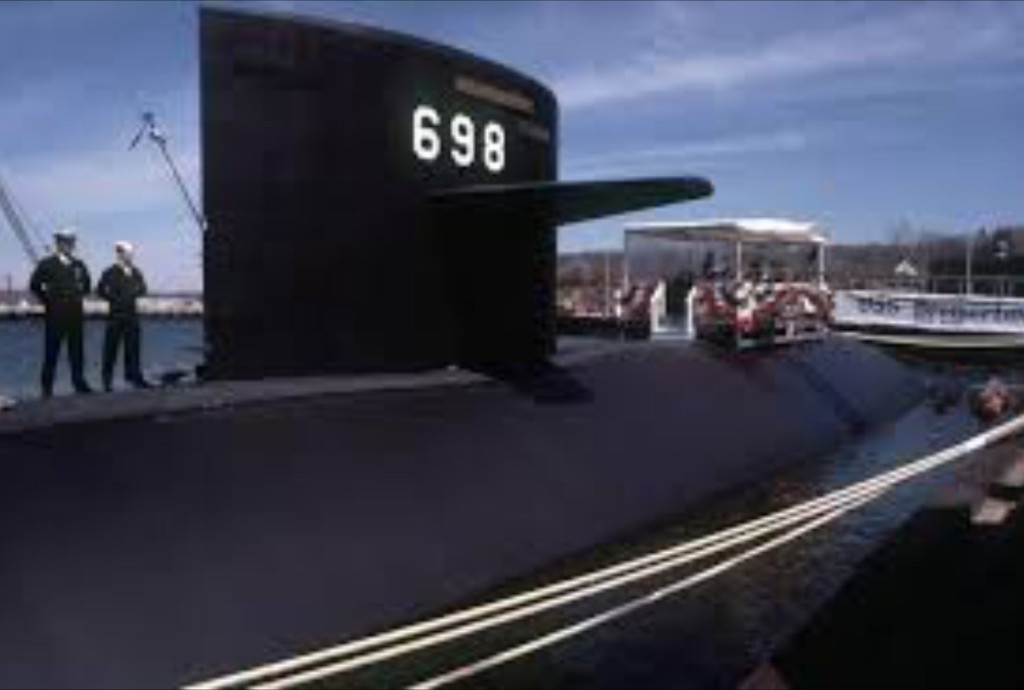
Newly minted submarine USS. Bremerton. (image source: Google).
THE NEED FOR SPEED
In 1981, the Bremerton had her work cut out as the new boat and crew completed their first certifications on the East Coast, before her long adventurous journey across the Atlantic, across the Indian Ocean and into the Pacific to her home port of Pearl Harbor. It was during her first years, Bremerton established the high speed record for US submarines which was a great source of pride and testosterone-engagement for every crew member who had their eyes on the knotmeter (speed indicator) every time we were ordered to a flank bell.
The Bremerton Captains of the early generations between 1978 and 1988 were Commanding Officers: Thomas H. Anderson, Douglas S. Wright and Alan R. Beam.
Officers and crew would take on the challenge of proving that the LA Class boat was no slouch in doing whatever was required in service to the national interests of the United States. They took this new addition to the submarine fleet, shook off the shipyard dust, exercised her thoroughbred nature, and revealed herself as ready, willing and able. Ultimately Bremerton became a real “hot-running” boat, meaning one with a high state of readiness and taking on a greater than the average number of important operations. Speed did play a major role in how 688’s were deployed. It seems like every where we went we were impressing ourselves with how fast we arrived.
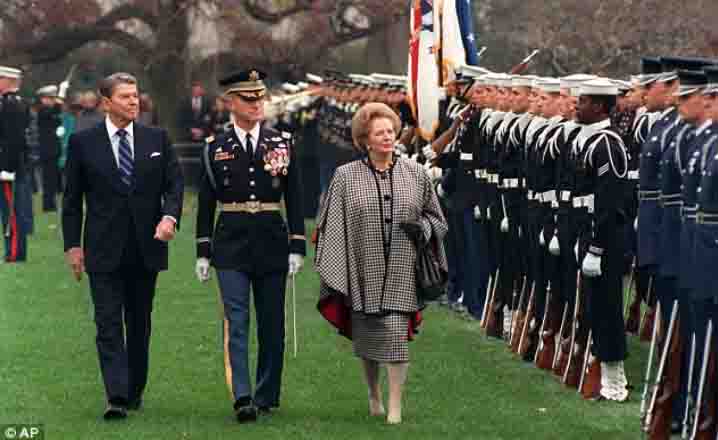
President Reagan and Prime Minister Thatcher reviewing troops. Image Credit: AP
Changes, Transitions, A Beginning
When President Ronald Reagan took office in 1981, many changes were occurring both in the military, culturally and strategically. The Bremerton crew-members experienced the major transitions that lasted through these early years. History has had a strong influence on the lives of those who served aboard which gave the crews of the first generations between 1978 (in the middle of an Cold War arms race) and 1988 (near and at the “end” of the Cold War) plenty to contemplate.
It is with this distinguished and complex background that the crewmembers of 30+ years ago, look back upon their service, sailors in the greatest naval force in the world and how they helped to bring the USS Bremerton to life to perform more than what she was originally designed for.
**
Looking Forward
USS Bremerton is home ported in Pearl Harbor, Hawaii, and is scheduled for decommissioning in late 2017. The average lifespan of a submarine is expected to be about 30 years, although I did read an article recently that spoke of being able to keep boats in service for up to 40 years with the right combinations of upkeep. Bremerton clearly resides in the successful old-timer category.
AND
Alumni of USS Bremerton (SSN698) are organizing a “30+ Year Reunion” scheduled to be held on August 22-25, 2016, in Reno, NV.
“The First Generation Bremerton Sailors from 1978 to 1986 are putting together a USS Bremerton 30+ year reunion which is also open to all active and past 698 shipmates from any generation who may want to attend.”
Details TBA, so remain on station for new developments.
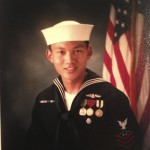
STS1/SS(DV) Challen Yee

My name is Robert Arnett and I served on the Bremerton from 82 to 86 and received the expeditionary medal for our part in the cold war. If there is anyone out there that remembers me contact me at robert.arnett@ymail.com.
Bob, Glad to hear from you! Are you on Facebook? If you are I can hook you up with your shipmates very quick, a lot of us are looking for you! I’ll let the guys know you’re out there! CK